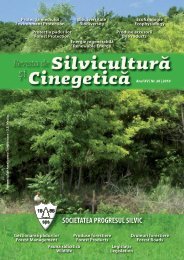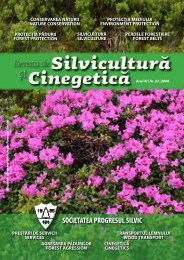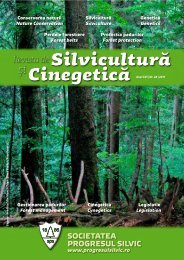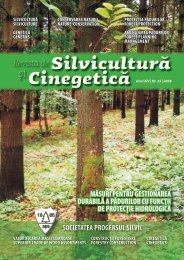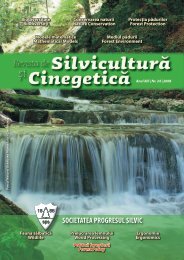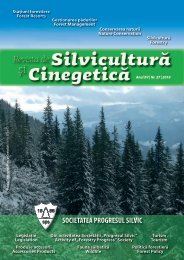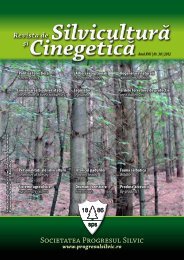Silviculture and Cinegetics Review - Societatea Progresul Silvic
Silviculture and Cinegetics Review - Societatea Progresul Silvic
Silviculture and Cinegetics Review - Societatea Progresul Silvic
Create successful ePaper yourself
Turn your PDF publications into a flip-book with our unique Google optimized e-Paper software.
FORESTRY BELTS SILVICULTURE AND CINEGETICS REVIEW XVII/30/2012<br />
shelterbelts will not benefit from the forest<br />
microclimate, the component species being forced to<br />
grow in more severe aridity conditions than those<br />
normally reflected by the forest vegetation in the<br />
region (Chiriţă et al., 1977; Geambaşu <strong>and</strong> Dănescu,<br />
2004; Stănescu et al., 1997). To establish the<br />
afforestation compositions, the technical norms have<br />
been taken into consideration (***, 2000).<br />
Therefore, in case of forest shelterbelts, the species<br />
choice <strong>and</strong> their participation proportion for different<br />
types of afforestation solutions are made according to<br />
the bioclimatic framing <strong>and</strong> the corresponding soil<br />
<strong>and</strong> ecological site conditions (Antonescu et al., 1969;<br />
Coteţ, 1973; Mihăilescu, 1969; ***, 2005), taking into<br />
consideration especially the basic indigenous <strong>and</strong><br />
representative species that are part of fundamental<br />
natural forest types in these areas (pubescent oak –<br />
Quercus pubescens, greyish oak – Quercus<br />
pedunculiflora, common oak – Quercus robur,<br />
Turkish oak – Quercus cerris, Hungarian oak –<br />
Quercus frainetto), as well as other indigenous species<br />
(silver lime – Tilia tomentosa, plane maple – Acer<br />
platanoides, hedge maple – Acer campestre, manna<br />
ash – Fraxinus ornus, pear tree – Pirus pyraster,<br />
cherry plum – Prunus cerasifera, different shrubs) or<br />
even exotical (Turkestan elm – Ulmus pumila,<br />
Russian olive – Eleagnus angustifolia), well known as<br />
drought-resistant.<br />
In the Danube Plain <strong>and</strong> Dobrogea, the variation of<br />
the ecological site conditions (soil <strong>and</strong> climate) within<br />
the territory allows the identification (differentiation)<br />
of eight soil <strong>and</strong> site situations to which the following<br />
afforestation compositions correspond:<br />
In Dobrogea<br />
I. Areas with kastanozioms (kastanozems – WRB –<br />
SR, 1998) in the steppe area<br />
In order to fit into an appropriate ecological site the<br />
areas covered with kastanozioms in which will be<br />
placed forest shelterbelts the following site type is<br />
recommended: „Dobrogean plain steppe (Quercus<br />
pubescens ± Quercus pedunculiflora), low<br />
productivity, long low inclined slopes, blunt tops of<br />
the hill or flat l<strong>and</strong>s, kastanozioms, highly edaphic<br />
volumes, physiologically shallow-medium deep“.<br />
For the afore-mentioned ecological site situation the<br />
use of the following afforestation composition is<br />
recommended: 40Stp 20Ult 20Sl 20arb.<br />
II. Areas with calcaric <strong>and</strong> typical chernozems<br />
(calcaro-calcic <strong>and</strong> calcic chernozems – WRB – SR,<br />
1998) in the steppe area<br />
The steppe areas with chernozems can be framed<br />
under the following ecological site type: ”Dobrogean<br />
plain steppe (Quercus pedunculiflora, Quercus<br />
pubescens), low productivity, long low inclined<br />
slopes, blunt tops of the hill or flat l<strong>and</strong>s, calcaric <strong>and</strong><br />
typical chernozems, high edaphic volumes,<br />
physiologically medium deep”. The following<br />
afforestation composition is recommended: 20Stb<br />
20Stp 20Ult 20Sl 20arb.<br />
III. Areas with cambic chernozems (haplic<br />
chernozems – WRB – SR, 1998) in the silvosteppe<br />
area (plain) <strong>and</strong> depressions in the steppe area<br />
(saucers, very large saucers)<br />
To frame into ecological forest site the areas of steppe<br />
<strong>and</strong> silvosteppe with cambic cernozioms the following<br />
ecological site type is recommended: ”Dobrogean<br />
plain silvosteppe <strong>and</strong> depressions in the steppe<br />
(Quercus pedunculiflora - Quercus pubescens),<br />
medium to low productivity, long <strong>and</strong> slight slopes,<br />
blunt tops of the hill, flat terrains <strong>and</strong> depression<br />
zones, cambic chernozems, slightly decarbonated,<br />
highly edaphic, physiologically medium deep”. In this<br />
situation the following afforestation composition is<br />
recommended: 40Stb 20Mj(Pă) 20Sl 20arb.<br />
In the Danube Plain<br />
IV. Areas with calcaric <strong>and</strong> typical chernozems<br />
(calcaro-calcic <strong>and</strong> calcic chernozems – WRB – SR,<br />
1998) <strong>and</strong> kastanozioms (kastanozems – WRB – SR,<br />
1998) in the external silvosteppe <strong>and</strong> medium<br />
silvosteppe<br />
These areas are recommended to be framed in the<br />
following ecological forest site type: ”External <strong>and</strong><br />
medium silvosteppe, medium productivity (Quercus<br />
pedunculiflora), calcaric <strong>and</strong> typical chernozems <strong>and</strong><br />
kastanozioms on loess substatum, physiologically<br />
medium deep to shallow, highly edaphic, loamy,<br />
medium humus content, with carbonates in the first 50<br />
cm, rarely carbonatic under 50 cm (with Cca horizon<br />
under the depth of 50-70 cm)”.<br />
Recommended composition: 40Stb 20Ult 20Sl 20arb.<br />
V. Areas with cambic chernozems (haplic chernozems<br />
– WRB – SR, 1998) in the middle silvosteppe The<br />
following ecological forest site is recommended for<br />
framing this areas: ”Medium silvosteppe, mediumhigh<br />
productivity (Quercus pedunculiflora), cambic<br />
chernozems on loess substratum, physiologically very<br />
deep (rare deep), high edaphic volume, loamy -<br />
clayey-loamy to maximum clayey-loamy soils (rare<br />
entirely loamy), moderate content in humus (rare<br />
medium to weak humiferous), without carbonates in<br />
the first 70 cm”.<br />
54



